Estate Jewelry: The Original Burning Man and A Ring For the Birds

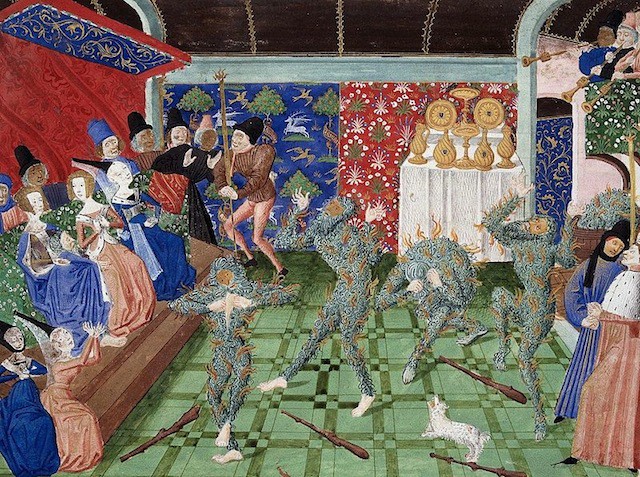
Masquerade balls have a long, colorful history. They’re believed to have originated in the Carnival traditions of medieval Italy (Venice in particular), but the custom soon spread to other Catholic countries and eventually reached England and America in the 18th century. One of the most famous, the Bal des Ardents, or “Ball of the Burning Men,” was held in in Paris in 1393 by the then Queen of France, Isabeau of Bavaria. Six members of the nobility, including her husband King Charles VI, performed a dance while in costume as “savage men.” Unfortunately, their shaggy costumes were wildly flammable, and when the king’s drunken brother leaned a torch over to try to see the identity of a dancer, an errant spark lit the man’s costume on fire and the flames quickly spread to the other dancers. Only two survived: one of the dancers saved himself by jumping into a vat of wine, and another — King Charles himself — was sheltered by his young aunt Joan, the Duchess of Berry, who threw her skirts over him to shield him from sparks. The incident is recorded in various illuminated manuscripts, including this one from Jean Froissart’s Chroniques, circa 1470–1472. On the left you can see Joan in blue, with the head of Charles sticking out from her skirts.
Infernos aside, masked balls were an excellent opportunity for flirtation. Many were held publicly, with members of society mixing with the lower classes, and they often drew accusations of immorality from detractors. Although masquerades tapered off somewhat after the 18th century, some notable masquerade balls were held in the 20th century, including Carlos de Beistegui’s Le Bal Oriental in Venice in 1951, and Truman Capote’s Black And White Ball in New York in 1966 (lots more on that one here).
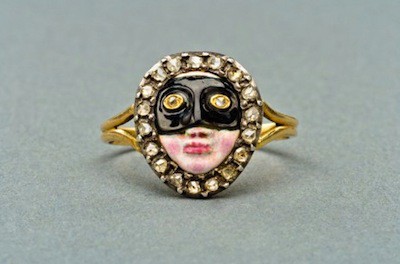
Anyway, this ring, circa 1800 and from England or Italy, is an example of this historic love for masquerades. It depicts an enameled, masked face, with rose-cut diamond eyes and a border of even more rose-cut diamonds set in silver on gold. The back of the ring is beautifully fashioned in the shape of a shell.
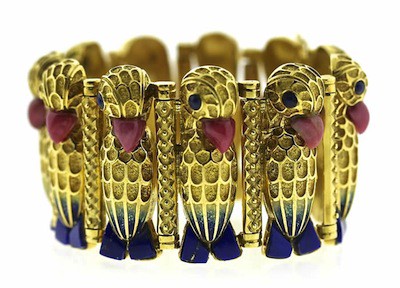
Parrots! This 18k gold bracelet is comprised of ten parrot links, each with a hand-cut rhodochrosite beak and lapis lazuli eyes and feet. The gold features a relief of stylized feathers highlighted with enamel in a gradated (ombre) shade of blue.
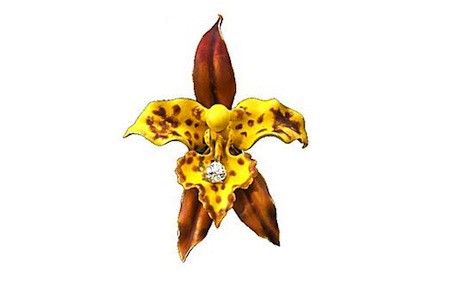
In 1889, Tiffany & Co. brought the Paris Exposition to its knees with a display of 24 brooches in the shape of jeweled orchids. Not content with merely presenting the pieces behind glass, they actually hung the orchids from above by fine wire, so that they floated ethereally above the company’s central display case. The flowers were created by Tiffany’s genius designer Paulding Farnham, and, according to John Loring’s book Tiffany Jewels, they were “universally acclaimed as the most original and finest jewels at the Paris Exposition,” and earned both Farnham and Tiffany & Co. the grand prize gold medal for jewelry.
Farnham created 24 orchid brooches for the Exposition, and they all sold within two days. In response to their popularity, Tiffany’s produced 15 more orchids in 1890, but the brooch featured here is one of the original 24. Modeled on the Odontoglossum Maculatum orchid, it is fashioned in yellow gold, with enameling and a central diamond.
Farnham went on to produce more acclaimed collections, many incorporating Native American, Asian or Aztec motifs, and his designs again won Tiffany the grand prize for jewelry at the Paris Exposition Universelle in 1900.
1902 saw the death of Charles Lewis Tiffany, the founder and president of Tiffany & Co., and his son, Louis Comfort Tiffany, assumed artistic control of the company. Of course one company can’t have two geniuses, so Farnham was quickly relegated to a lesser role. He contributed no jewelry to the Turin International Exposition of 1902, and only one necklace to St. Louis’s Louisiana Purchase Exposition in 1904.
Farnham finally left the company in 1908 at the age of 48, and never designed jewelry again. If you’re interested, there’s a more in-depth look at Farnham’s life here.
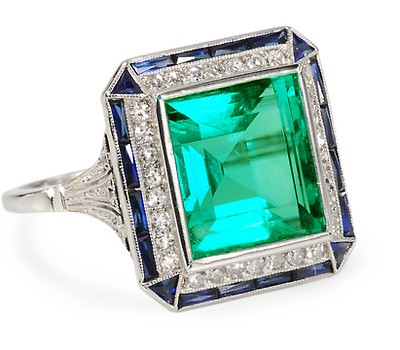
This Art Deco ring, circa 1925, showcases one of the clearest, prettiest emeralds I’ve ever seen. Natural emeralds usually have inclusions (tiny bits of minerals, liquids, gases, etc.) within the stone that are visible to the eye, but this one has hardly any.
The emerald is estimated at 5.25 carats and is set in platinum. It’s framed with thirty old-single-cut diamonds, and four triangular-cut synthetic sapphires sit at the corners, with an additional border of sapphires in between. Synthetic sapphires are actually physically and chemically identical to natural sapphires, but they’re man-made to reduce flaws. Blue sapphires were one of the most popular stones to be paired with diamonds in Art Deco designs, so synthetics became a very popular option when French chemist Auguste Verneuil developed a process for their manufacture in the beginning of the 20th century.
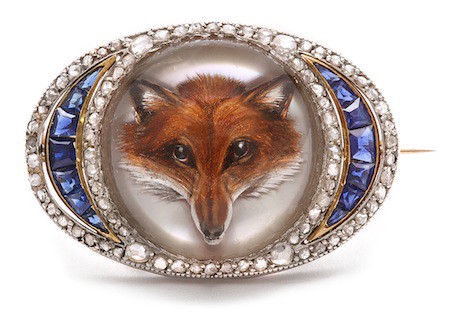
Circa 1900, this brooch is a beautiful example of “reverse crystal” jewelry. Reverse crystals became popular in England during the second half of the 19th century, and they’re created by carving an intaglio into the flat back of a cabochon-cut crystal. The intaglio is then painted — sometimes in ridiculously intricate detail — and the back is usually covered with a disc of mother of pearl to protect the painting. When viewed from the front, the convex crystal emphasizes the depth of the image carved into the back, making it look remarkably three-dimensional.
Reverse crystals are often referred to as “Essex crystals,” which stems from a misattribution to an artist who did not actually create reverse crystals, but the name stuck.
The crystals were set into cufflinks, brooches, tiepins and various other jewelry items, and many of them — including this brooch — feature hunt motifs. This English brooch places a fox crystal in a setting of gold and platinum, with a border of diamonds and sapphires. The fox is carved and painted with incredible sensitivity; sometimes brushes containing only one hair were used to paint these crystals, and you can see the resulting lightness of touch here.
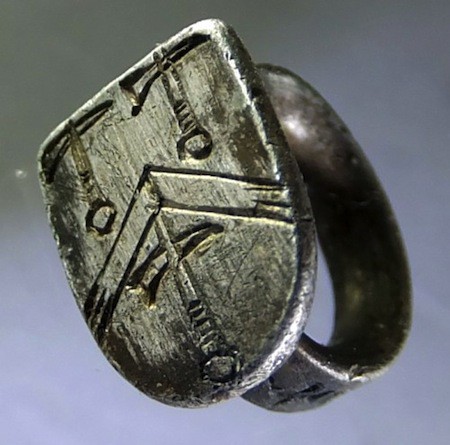
Now this is unusual. It’s called a vervel or hawking ring, and instead of being placed on a human hand, it would have rested around the leg of a hawk. Hawking (or falconry) has for centuries been a popular pastime of the upper classes and aristocracy, and these bands were used as identification if a bird got lost.
This particular ring is silver and dates to the 16th century. The shield features the arms of the London Company of Blacksmiths & Spurriers, which is one of the early Livery Companies (or trade associations) of London. The side of the ring is also engraved with “Chadwell of North,” which the dealer believes is a reference to an area in Northampton — although I wonder if it could be the name of the owner?
Recently, a metal detector in Norfolk turned up a royal vervel that bears the arms of Charles Brandon, the first Duke of Suffolk and husband of Mary Tudor. Brandon was a close personal friend of Henry VIII, and the vervel also features the royal coat of arms.
The “if it is declared treasure” statement in the article refers to England’s Treasure Act of 1996, which states that landowners hold the title to any items found on their property. Anything that may fit into the Act’s definition of “treasure,” however, must first be handed over to the local coroner. If the coroner determines that the piece is actually treasure (I love that they use this word so formally!), it must then be offered for sale to a museum at a price set by an independent board of experts. If the museum isn’t interested in (or can’t afford) the piece, it then reverts back to the owner, and is theirs to keep or to sell.
Falconry continues as a sport today, and all birds must be registered and ringed, and many are also micro-chipped. The US and UK both have association websites that maintain registries, so lost or injured birds can be reunited with their owners.
Maybe that’s enough bird information for you today, but if you’re interested, a brief tangent: racing/ homing pigeons have a similar network, and the breeding and training of these unfairly maligned birds saved the lives of thousands of people during World War II. Homing pigeons were used to carry messages and coordinates through enemy territory, fighting bombs, gunfire and even German hawks. The skeleton of a WWII homing pigeon was actually found last year with a coded message — which nobody has been able to decipher, since the key was probably destroyed — still strapped to its leg.
England awarded a medal for bravery to 53 animals during WWII, and 32 of the recipients were pigeons. (You can read about each of their wartime escapades here.) So the moral of this story is: Be nice to pigeons. Also, Mary the pigeon was a badass.
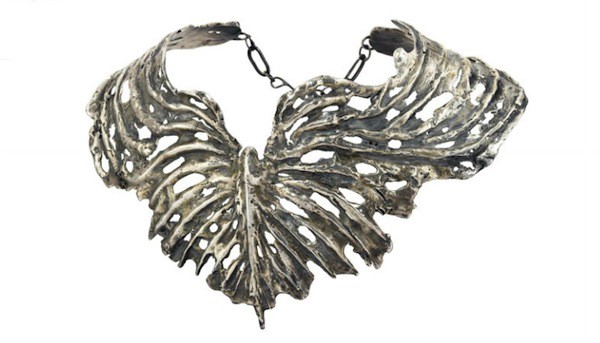
Christie’s is holding an “Out of the Ordinary” auction on September 5 in London, and it includes this impressive collar. Circa 1970, the necklace was created by Judith Brown (1931–1992), who cast cabbage leaves in silver to create the shape of a butterfly. Brown was a New York sculptor known for incorporating scrap metal and junkyard objects into her work, which is included in the collections of various museums including the Museum of Modern Art. She also created jewelry using unconventional materials, such as leaves or bark.
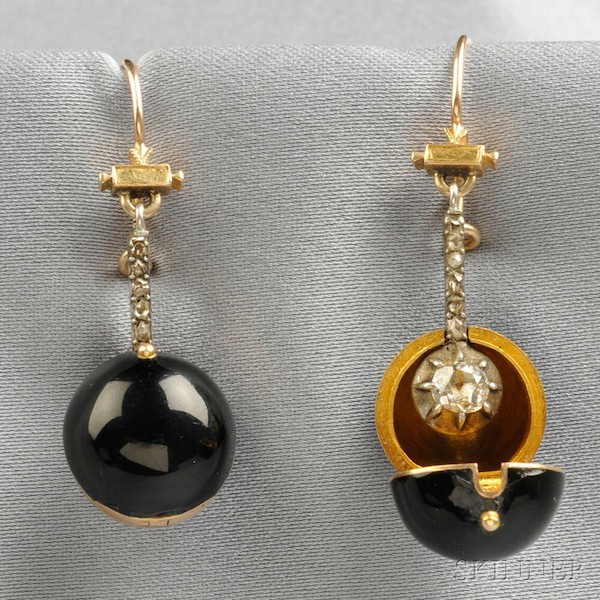
There are some gorgeous items in the Skinner Fine Jewelry auction on September 10 in Boston, so please click through to view the whole sale. I’ve chosen to highlight these fairly inexpensive and understated diamond earrings, though, because they’re a fun little window into jewelry history. You see those little black spheres? They actually detach completely from the earrings. They’re called “coach covers,” and they were used during the late 1800s as daytime or travel camouflage for diamond drops. They just snap right over top! This pair is made of gold and enamel, and the Metropolitan Museum of Art has a very similar set.
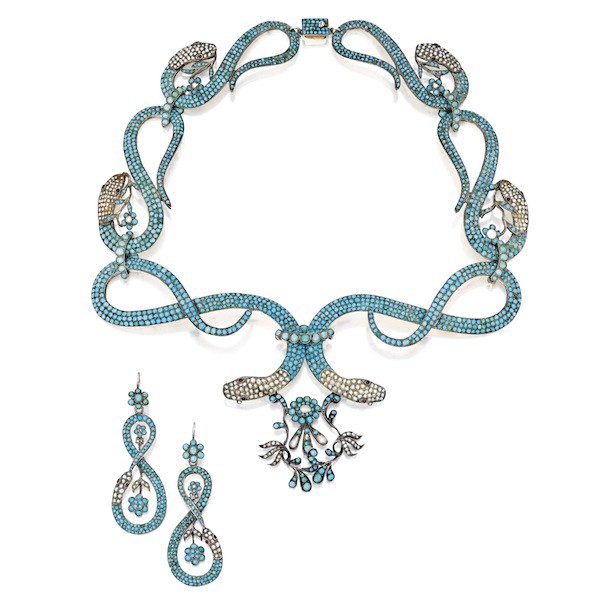
The Sotheby’s Important Jewels auction on September 24 in New York also has some killer pieces on the block (including this ridiculous 15.10 carat pear-shaped diamond ring), but this necklace blew my mind. Circa 1830, it links six turquoise, seed pearl and silver-gilt snakes (with garnet eyes) to form a bright and sinuous collar. The piece is finished off with a central floral motif and there’s also a set of matching earrings, because why the hell not.
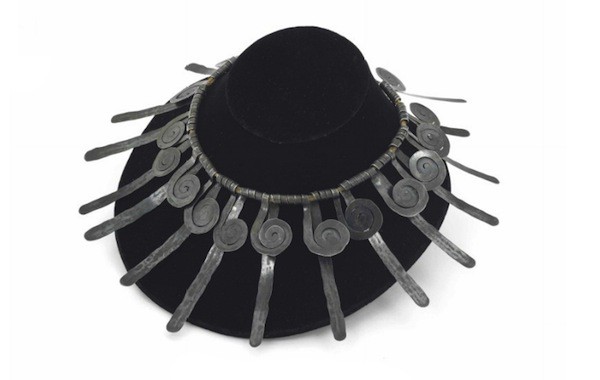
The Christie’s First Open auction on September 26–27 in New York will include this necklace, circa 1940, by the renowned American artist Alexander Calder (1898–1976). Made of silver wire and cord, its simple spiral design was influenced by the Bronze Age artifacts and African sculpture that Calder saw at local museums while he lived in Paris.
That’s not the kicker, though. This necklace was actually bought by a lady from Philadelphia at a flea market in Brooklyn. She paid $15. She had no idea what it was until years later, when she saw a similar necklace on the cover of a local newspaper. The paper was covering a Calder jewelry exhibit at the Philadelphia Museum of Art, so she got in touch with the curator, and then brought the necklace to the Calder Foundation in New York, where it was confirmed and registered. It’s estimated at $200,000–300,000. Yep. $15.
Previously: Mystery Pearls and Secret Love Messages
Monica McLaughlin tweets about jewelry and frozen dead people at @rococopacetic. She is a friend to pigeons everywhere.